形容词副词比较级和最高级有规则变化和不规则变化
英语形容词和副词的比较级和最高级
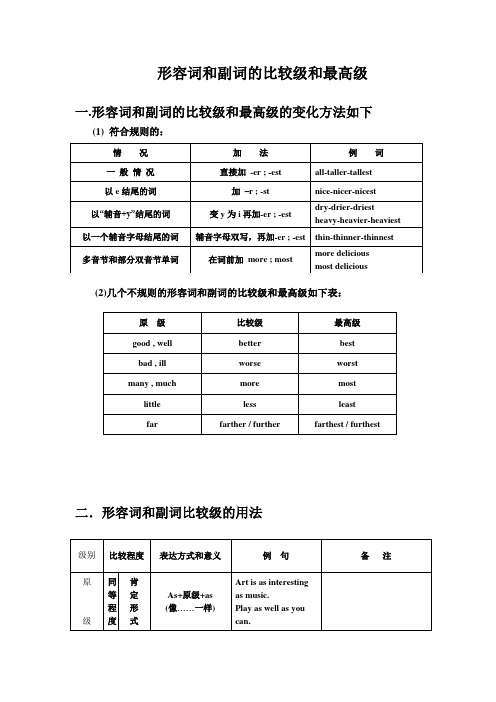
形容词和副词的比较级和最高级一.形容词和副词的比较级和最高级的变化方法如下(1) 符合规则的:(2)几个不规则的形容词和副词的比较级和最高级如下表:二.形容词和副词比较级的用法注意:有些形容词,如 dead, empty, round, sure, woolen 等受本身含义的限制,没有比较级。
例题解析1. He is ________ friends than I.A. much moreB. many moreC. very moreD. too more解析:后面有可数名词复数时,many的比较级形式为many more 修饰。
应选B.2. Which is the _________ country, Japan or Australia?A. more developedB. more developingC. most developedD. most developing解析:两者比较用比较级,表示"发达"用developed, 而developing 是"发展中的" 意思3. There were _______ shops in the city in 1982 than in 1990.A. littleB. fewC. fewerD. less解析:little 不能修饰可数名词,两者比较需用比较级,所以应选C.4. If you are not free today, come another day __________.A. tooB. soC. insteadD. yet解析:instead 作副词用时意为"代替,顶替",表示前面的事情没做,而是做了后面的事。
Instead一般位于句首。
应选C.5.He can't tell us ________, I think.A. important anythingB. anything importantC. important somethingD. something important.解析:不定代词与形容词联用需后置,否定句中应该用anything而不是something. 因此应选B6. The Huang River is the second __________ river in our country.A. longB. longerC. longestD. the longest解析:"定冠词the+ 序数词+ 形容词最高级" 表示"第几大……" 应选C.7. The light in the office wasn't ________for him to read.A. enough brightB. bright enoughC. brightlyD. enough brightly解析:enough修饰名词时可前可后,修饰形容词或副词时,要后置。
形容词和副词的比较级和最高级变化规则

形容词和副词的比较级和最高级变化规则摘要:一、形容词和副词的比较级1.规则变化2.不规则变化二、形容词和副词的最高级1.规则变化2.不规则变化三、实际应用与例子1.形容词比较级和最高级的应用2.副词比较级和最高级的应用正文:在我们学习英语时,了解形容词和副词的比较级和最高级变化规则是非常重要的。
这不仅有助于我们更好地理解和使用英语,还能帮助我们提高英语口语和写作能力。
接下来,我们将详细介绍形容词和副词的比较级和最高级变化规则。
一、形容词和副词的比较级形容词和副词的比较级用于表示事物之间的比较关系。
在英语中,形容词和副词的比较级可以通过以下两种方式进行变化:1.规则变化在规则变化中,形容词和副词的比较级通常是在词尾加上“-er”或“more”。
例如:- happy(高兴)的比较级是happier。
- fast(快)的比较级是faster。
2.不规则变化在英语中,有些形容词和副词的比较级是不规则的。
例如:- good(好)的比较级是better。
- bad(坏)的比较级是worse。
二、形容词和副词的最高级形容词和副词的最高级用于表示事物之间的最高程度。
在英语中,形容词和副词的最高级可以通过以下两种方式进行变化:1.规则变化在规则变化中,形容词和副词的最高级通常是在词尾加上“-est”或“most”。
例如:- happy(高兴)的最高级是happiest。
- fast(快)的最高级是fastest。
2.不规则变化在英语中,有些形容词和副词的最高级是不规则的。
例如:- good(好)的最高级是best。
- bad(坏)的最高级是worst。
三、实际应用与例子1.形容词比较级和最高级的应用了解形容词的比较级和最高级对于我们在日常生活中进行比较是非常有帮助的。
例如:- This apple is redder than that one.(这个苹果比那个更红。
)- The tallest man in our class is Tom.(我们班最高的男生是汤姆。
形容词副词的比较级和最高级变化规则
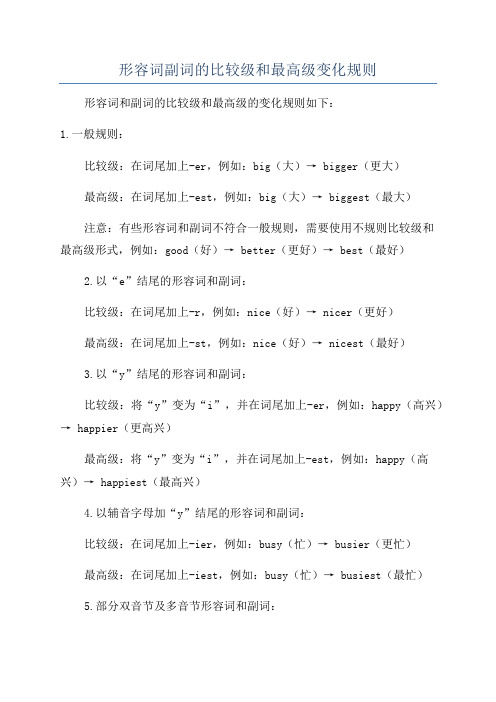
形容词副词的比较级和最高级变化规则形容词和副词的比较级和最高级的变化规则如下:
1.一般规则:
比较级:在词尾加上-er,例如:big(大)→ bigger(更大)
最高级:在词尾加上-est,例如:big(大)→ biggest(最大)
注意:有些形容词和副词不符合一般规则,需要使用不规则比较级和
最高级形式,例如:good(好)→ better(更好)→ best(最好)
2.以“e”结尾的形容词和副词:
比较级:在词尾加上-r,例如:nice(好)→ nicer(更好)
最高级:在词尾加上-st,例如:nice(好)→ nicest(最好)
3.以“y”结尾的形容词和副词:
比较级:将“y”变为“i”,并在词尾加上-er,例如:happy(高兴)→ happier(更高兴)
最高级:将“y”变为“i”,并在词尾加上-est,例如:happy(高兴)→ happiest(最高兴)
4.以辅音字母加“y”结尾的形容词和副词:
比较级:在词尾加上-ier,例如:busy(忙)→ busier(更忙)
最高级:在词尾加上-iest,例如:busy(忙)→ busiest(最忙)
5.部分双音节及多音节形容词和副词:
比较级:在前面加上more
最高级:在前面加上most,例如:beautiful(美丽)→ most beautiful(最美丽)
6.不规则形容词和副词:
比较级和最高级的形式不按照规律变化,需要记忆特定形式,例如:good(好)→ better(更好)→ best(最好)
总之,形容词和副词的比较级和最高级变化规则是有规律可循的,但也存在一些不规则形式需要特别记忆。
形容词,副词比较级和最高级的变化规则及用法

形容词/副词比较级和最高级变化规则及用法形容词/副词原级都有相应的比较级和最高级,它们有些是规则变化的,有些是不规则变化的,具体变化规则及用法如下:●规则变化:Tips:少数形容词以辅音字母+ y结尾,仍直接在其后面+er, est,分别表示比较级和最高级,如:shy-shyer-shyest●不规则变化:●形容词和副词的比较级用法如下:1)比较级+ than 意为“比……更……”,比较级前面一般搭配“much,far,alittle,even,rather,a lot,a bit still”等词使用,进行用于进行程度上的限定。
参考例句:Cat are much more lovely than many other animals.猫比其他动物都可爱得多。
2)the+比较级,the+比较级“越……越……”参考例句:The more you eat, the fatter y ou become.你吃的越多,长得越胖。
3)( not) as +原级+ as 意为“和……不一样”参考例句:Her skin is as white as snow.她的皮肤和雪一样白。
Tips:形容词/副词中间+名词时用法为:✧as+adj+a/an+单数名词+as✧as many/much/few/little+复数可数名词/不可数名词+as参考例句:We have produced as many toys as we did last year.我们生产的玩具数量和去年一样多。
4)the+最高级+比较范围,b表示3者或3者以上的比较,比较范围通常是用“of,among,in等引导的短语”参考例句:This experiment is almost the easiest among all.在所有实验中,这个实验差不多是最简单的。
倍数表达法1)a+谓语+倍数+比较级+ than+b 意思为“a 是b的多少倍”参考例句:John is twice heavier than his younger brother.约翰的体重是他弟弟体重的2倍。
形容词副词比较级和最高级规律和不规则变化
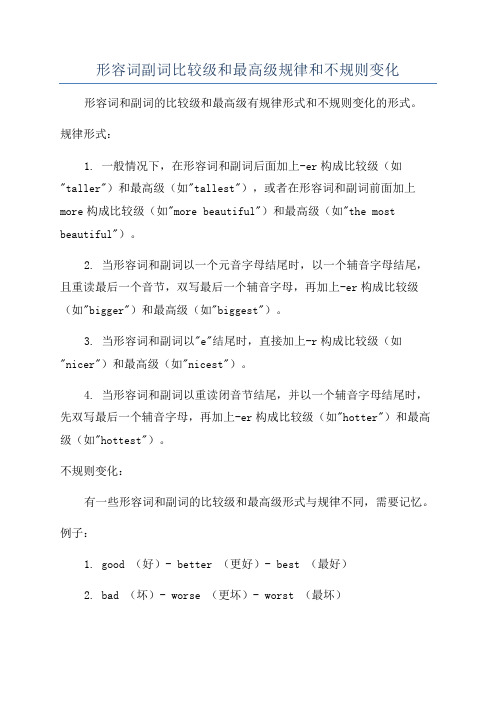
形容词副词比较级和最高级规律和不规则变化形容词和副词的比较级和最高级有规律形式和不规则变化的形式。
规律形式:1. 一般情况下,在形容词和副词后面加上-er构成比较级(如"taller")和最高级(如"tallest"),或者在形容词和副词前面加上more构成比较级(如"more beautiful")和最高级(如"the most beautiful")。
2. 当形容词和副词以一个元音字母结尾时,以一个辅音字母结尾,且重读最后一个音节,双写最后一个辅音字母,再加上-er构成比较级(如"bigger")和最高级(如"biggest")。
3. 当形容词和副词以"e"结尾时,直接加上-r构成比较级(如"nicer")和最高级(如"nicest")。
4. 当形容词和副词以重读闭音节结尾,并以一个辅音字母结尾时,先双写最后一个辅音字母,再加上-er构成比较级(如"hotter")和最高级(如"hottest")。
不规则变化:有一些形容词和副词的比较级和最高级形式与规律不同,需要记忆。
例子:1. good (好)- better (更好)- best (最好)2. bad (坏)- worse (更坏)- worst (最坏)3. far (远)- further/farther (更远)- furthest/farthest (最远)4. many/much (多)- more (更多)- most (最多)5. little (少)- less (更少)- least (最少)6. well (好)- better (更好)- best (最好)7. badly (坏)- worse (更坏)- worst (最坏)需要注意的是,有些形容词和副词只有原级,没有比较级和最高级,如perfect(完美的)、unique(独一无二的)、correct(正确的)等。
形容词比较级和最高级
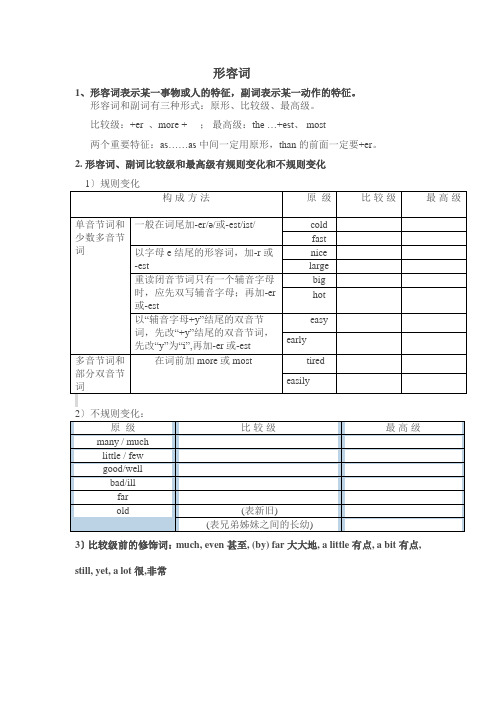
3〕比较级前的修饰词:much, even甚至, (by) far大大地, a little有点, a bit有点, still, yet, a lot很,非常常考知识点一:形容词的比较级和最高级的构成〔1〕.以不发音的e结尾,直接加-r或-st:nice—nicer—nicest large—larger—largest〔2〕.以辅字母+y结尾的,变y为i,再加-er或-est:easy—easier—easiest happy—happier—happiest〔3〕.以“辅元辅”结尾的,双写末尾字母,再加-er或-est: big—bigger—biggest常见的还有:thin, fat, wet, red, sadhot—hotter—hottest〔4〕.不规则变化: good—better—best many/much—more—most (好坏多少远老) bad—worse—worst little(少)—less—leastfar—farther/further—farthest/furthestold—older/elder—oldest/eldest错,few—fewer new—newer—newest clever—cleverer tired—moretired pleased—more pleased常考知识点二:含有比较级的句型结构1) A is ...than B: A比B更.... The earth is bigger than the moon.2) A do sth ...than B: A比B更.... He works harder than us.【中考题】China has become much__________(strong)than before. We are proud of her.3)Which/ Who is ...., A or B? “A和B哪个/谁更...?”4)... and ... “越“越来越...”When spring comes, the days are getting longer and longer.5、Three students ran faster than Lily in the race. Lily was ________.(2012年佛山,34)A. the fourthB. fourC. the thirdD. three6、—Is Beijing a city with a long history? (2012年湛江,23)— Of course. And after the Olympic Games, __ people came to Beijing for a visit during the vacation.A. thousands ofB. thousandC. five thousandsD. five thousand of二、用所给词的适当形式填空。
(完整版)初二形容词副词比较级、最高级
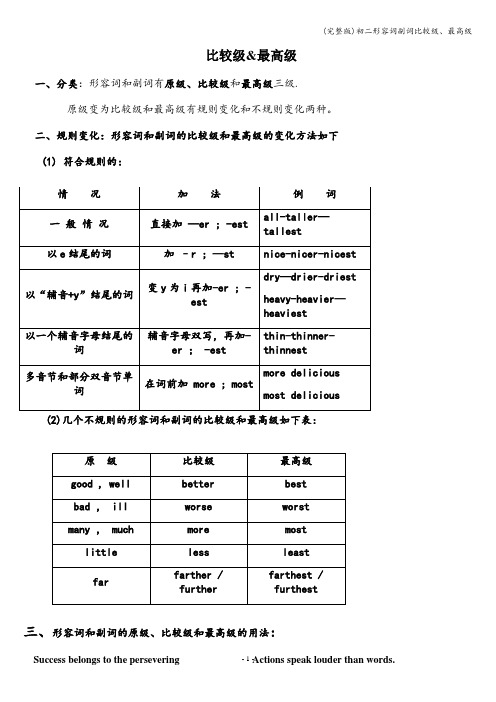
比较级&最高级一、分类:形容词和副词有原级、比较级和最高级三级.原级变为比较级和最高级有规则变化和不规则变化两种。
二、规则变化:形容词和副词的比较级和最高级的变化方法如下(1) 符合规则的:(2)几个不规则的形容词和副词的比较级和最高级如下表:三、形容词和副词的原级、比较级和最高级的用法:1e.g。
This room is bigger than that one. I am taller than you。
This lesson is more difficult than that one.注意:①修饰比较级的词有 a little, a bit ,a few , a lot ,much, even,still,far,rather,any 等表程度。
e。
g。
Today is _________ colder than yesterday(冷得多/一点)②为避免重复,在从句中常用the one 代替可数名词单数形式,调和ones 或those代替可数名词的复数形式,that代替不可数名词.E。
g。
The weather in Tianjin is colder than______of Guangzhou in winter.2、表示“…不如…”,用“less+原级+than”结构e。
g. The book is less difficult than that one. The film is less interesting than that one3、不与其他事物相比,表示本身程度的改变,用“比较级+and+比较级”结构,意思是“越来越…”e.g。
The weather is getting______ ______ 。
______ (越来越暖和)Our country is becoming _____ ______ . ______ (越来越漂亮)4、表示“两者之间比较。
(总)形容词比较级和最高级规律和不规则变化
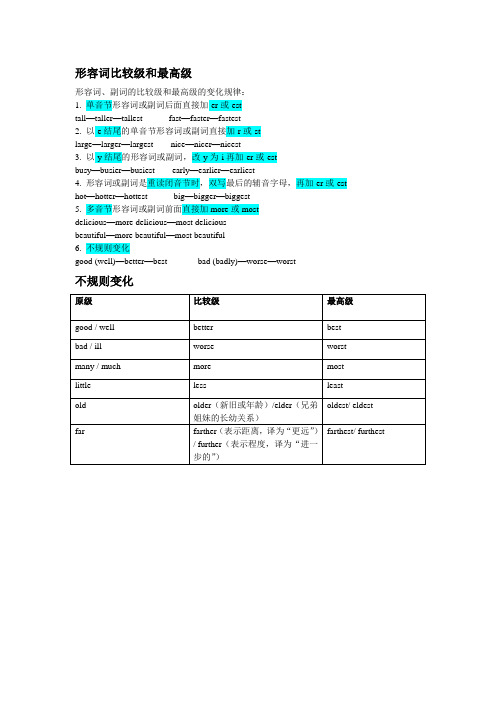
beautiful—more beautiful—most beautiful
6.不规则变化
good (well)—better—best bad (badly)—worse—worst
不规则变化
原级
比较级
最高级
good /Байду номын сангаасwell
better
best
bad / ill
worse
worst
many / much
more
most
little
less
least
old
older(新旧或年龄)/elder(兄弟姐妹的长幼关系)
oldest/ eldest
far
farther(表示距离,译为“更远”)/ further(表示程度,译为“进一步的”)
形容词比较级和最高级
形容词、副词的比较级和最高级的变化规律:
1.单音节形容词或副词后面直接加-er或-est
tall—taller—tallest fast—faster—fastest
2.以-e结尾的单音节形容词或副词直接加-r或-st
large—larger—largest nice—nicer—nicest
3.以-y结尾的形容词或副词,改-y为-i再加-er或-est
busy—busier—busiest early—earlier—earliest
4.形容词或副词是重读闭音节时,双写最后的辅音字母,再加-er或-est
hot—hotter—hottest big—bigger—biggest
5.多音节形容词或副词前面直接加more或most
形容词和副词比较级最高级的变化规则
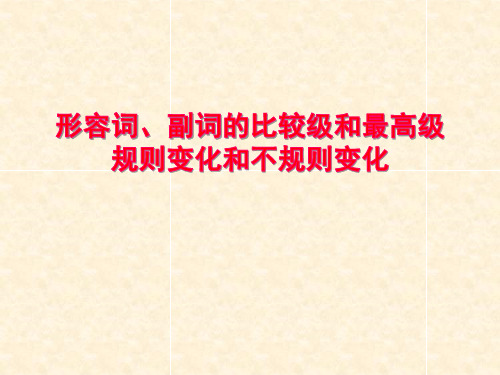
去: 2) 以不发音e结尾的词,去e+er,最高级 去e+st 。 如: nice — nicer — nicest cute — cuter — cutest large — larger — largest
双: 3)重读闭音节,辅音字母结尾的,双写这 个辅音字母+er 或 est: ① wet — wetter — wettest ② hot — hotter — hottest ③ fat — fatter — fattest ④ thin — thinner — thinnest ⑤red — redder — reddest ⑥ big — bigger — biggest ⑧ sad —sadder —saddest
英语中形容词和副词有比较等级的变化,即原级、比 较级和最高级,用来表示事物的某种性质在程度上的差别。 形容词和副词的比较级和最高级规则变化和不规则变 化我们用五个字来括,就是
直,去,双,改,特
直 :
1)一般情况下,单音节或双音节的形容词/副词 比较级后直接+er, 最高级+est。 如: clever — cleverer — cleverest few — fewer — fewest small — smaller — smallest
特:“特”指的是不规则变化: 我们可以用5个字概括 :好,坏,多,少,远 好 good (well) — better — best 坏 bad (badly、 ill) — worse — worst 多 many/much — more — most 少 little —less —least 远 far —farther —farthest further —furthest
改: 4)辅音字母+y结尾的改y为i+er 或est 如: easy — easier — easiest happy — happier — happiest early, busy, heavy, dirty, lazy ….
形容词、副词比较级、最高级变化规则及用法
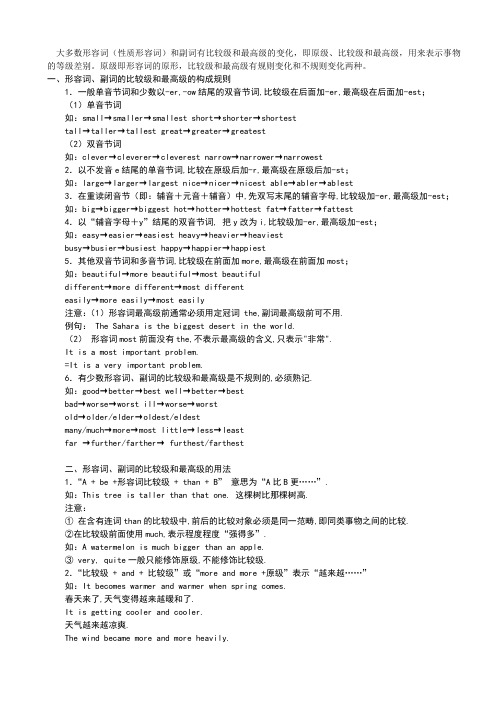
大多数形容词(性质形容词)和副词有比较级和最高级的变化,即原级、比较级和最高级,用来表示事物的等级差别。
原级即形容词的原形,比较级和最高级有规则变化和不规则变化两种。
一、形容词、副词的比较级和最高级的构成规则1.一般单音节词和少数以-er,-ow结尾的双音节词,比较级在后面加-er,最高级在后面加-est;(1)单音节词如:small→smaller→smallest short→shorter→shortesttall→taller→tallest great→greater→greatest(2)双音节词如:clever→cleverer→cleverest narrow→narrower→narrowest2.以不发音e结尾的单音节词,比较在原级后加-r,最高级在原级后加-st;如:large→larger→largest nice→nicer→nicest able→abler→ablest3.在重读闭音节(即:辅音+元音+辅音)中,先双写末尾的辅音字母,比较级加-er,最高级加-est;如:big→bigger→biggest hot→hotter→hottest fat→fatter→fattest4.以“辅音字母+y”结尾的双音节词, 把y改为i,比较级加-er,最高级加-est;如:easy→easier→easiest heavy→heavier→heaviestbusy→busier→busiest happy→happier→happiest5.其他双音节词和多音节词,比较级在前面加more,最高级在前面加most;如:beautiful→more beautiful→most beautifuldifferent→more different→most differenteasily→more easily→most easily注意:(1)形容词最高级前通常必须用定冠词 the,副词最高级前可不用.例句: The Sahara is the biggest desert in the world.(2)形容词most前面没有the,不表示最高级的含义,只表示"非常".It is a most important problem.=It is a very important problem.6.有少数形容词、副词的比较级和最高级是不规则的,必须熟记.如:good→better→best well→better→bestbad→worse→worst ill→worse→worstold→older/elder→oldest/eldestmany/much→more→most little→less→leastfar →further/farther→ furthest/farthest二、形容词、副词的比较级和最高级的用法1.“A + be +形容词比较级 + than + B”意思为“A比B更……”.如:This tree is taller than that one. 这棵树比那棵树高.注意:①在含有连词than的比较级中,前后的比较对象必须是同一范畴,即同类事物之间的比较.②在比较级前面使用much,表示程度程度“强得多”.如:A watermelon is much bigger than an apple.③ very, quite一般只能修饰原级,不能修饰比较级.2.“比较级 + and + 比较级”或“more and more +原级”表示“越来越……”如:It becomes warmer and warmer when spring comes.春天来了,天气变得越来越暖和了.It is getting cooler and cooler.天气越来越凉爽.The wind became more and more heavily.风变得越来越大.Our school is becoming more and more beautiful.我们的学校变得越来越美丽.3.在含有or的选择疑问句中,如果有两者供选择,前面的形容词要用比较级形式.如:Who is taller,Tim or Tom? 谁更高,Tim还是Tom?4. “the +比较级……, the+比较级”,表示“越……越……”.The more money you make, the more you spend.钱你赚得越多,花得越多.The sooner,the better.越快越好.5. 表示倍数的比较级用法:①. A is …times the size /height/length/width of B.如:The new building is three times the height of the old one.这座新楼比那座旧楼高三倍.(新楼是旧楼的四倍高)②. A is …times as big /high/long/wide/large as B.如:Asia is four times as large as Europe.亚洲是欧洲的四倍大.(亚洲比欧洲大三倍)③. A is …times larger /higher/longer/wider than B.如:Our school is twice bigger than yours.我们学校比你们学校大两倍.6.形容词、副词的最高级形式主要用来表示三者或三者以上人或事物的比较,表示“最……”的意思.句子中有表示范围的词或短语.如:of the three, in our class等等.如:He is the tallest in our class.他在我们班里是最高的.7."否定词语+比较级","否定词语+ so… as"结构表示最高级含义.Nothing is so easy as this.=Nothing is easier than this.=This is the easiest thing.8. 比较级与最高级的转换:Mike is the most intelligent in his class.Mike is more intelligent than any other student in his class7.修饰比较级和最高级的词1)可修饰比较级的词①.a bit, a little, rather, much, far, by far, many, a lot, lots, a great deal, any, still, even等.②. 还可以用表示倍数的词或度量名词作修饰语.③. 以上词(除by far)外,必须置于比较级形容词或副词的前面.注意:使用最高级要注意将主语包括在比较范围内.(错) Tom is the tallest of his three brothers.(对) Tom is the tallest of the three brothers.2)下列词可修饰最高级:by far, far, much, mostly, almost.This hat is nearly / almost the biggest.注意:a. very可修饰最高级,但位置与much不同.This is the very best.This is much the best.b. 序数词通常只修饰最高级.Africa is the second largest continent.8.要避免重复使用比较级.(错) He is more cleverer than his brother.(对) He is more clever than his brother.(对) He is cleverer than his brother.9.要避免将主语含在比较对象中.(错) China is larger that any country in Asia.(对) China is larger than any other country in Asia.10.要注意对应句型,遵循前后一致的原则.The population of Shanghai is larger than that of Beijing.It is easier to make a plan than to carry it out.11.要注意冠词的使用,后有名词的时候,前面才有可能有名词.比较:Which is larger, Canada or Australia?Which is the larger country, Canada or Australia?She is taller than her two sisters.She is the taller of the two sisters.常用的不规则变化的形容词的比较级和最高级:原级------比较级------最高级good------better------best well------better------bestmany------more------most much------more------mostbad------worse------worst 坏的 ill--------worse-------worst 病的few------less-------least 少数几个 little-------less------least 少数一点儿far------further------furthest 更进一步,程度 far------farther------farthest 更远,路程old-------older------oldest 年老的(指年纪) old------elder-------eldest 年老的(指兄弟姐妹的排行)形容词前如加 less 和 least 则表示"较不"和"最不"important 重要 less important 较不重要 least important 最不重要。
形容词、副词的比较级、最高级变化形式归纳
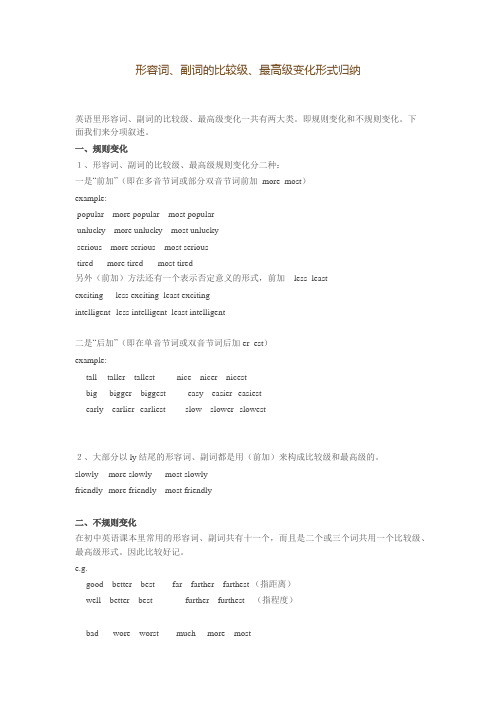
形容词、副词的比较级、最高级变化形式归纳英语里形容词、副词的比较级、最高级变化一共有两大类。
即规则变化和不规则变化。
下面我们来分项叙述。
一、规则变化1、形容词、副词的比较级、最高级规则变化分二种:一是“前加”(即在多音节词或部分双音节词前加 more most)example:popular---more popular---most popularunlucky---more unlucky---most unluckyserious---more serious---most serioustired ----more tired-----most tired另外(前加)方法还有一个表示否定意义的形式,前加less leastexciting --less exciting least excitingintelligent--less intelligent least intelligent二是“后加”(即在单音节词或双音节词后加 er est)example:tall --taller---tallest nice---nicer---nicestbig --bigger---biggest easy---easier--easiestearly---earlier--earliest slow---slower--slowest2、大部分以 ly 结尾的形容词、副词都是用(前加)来构成比较级和最高级的。
slowly --more slowly ---most slowlyfriendly--more friendly---most friendly二、不规则变化在初中英语课本里常用的形容词、副词共有十一个,而且是二个或三个词共用一个比较级、最高级形式。
因此比较好记。
e.g.good---better---best far---farther---farthest (指距离)well---better---best ---further---furthest(指程度)bad-----wore---worst much----more---mostbadly---wore---worst many----more---mostill---- wore---worst some----more---mostlittle---less---leastold---elder---eldest(指家庭关系中年长的)old---older---oldest(属于规则变化,泛指年龄大的)注:elder不能与than连用,只能用作定语修饰名词。
形容词和副词的比较级和最高级大多数形容词和副词有三个
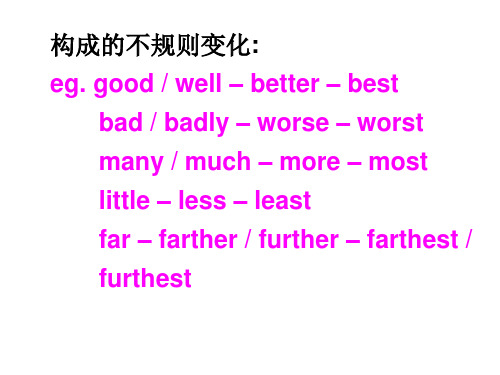
egg. easy – easier – easiest happy – happier – happiest
多音节词和部分双音节词在词前加 more或 most。 eg. delicious – more delicious
– most delicious interesting – more interesting
3. I’m sorry. I can’t. I have to ______ (help) my mom.
4. There ______(not be )any bread at home yesterday.
5. Tom ____(have) no time last Sunday. He ___ (visit) his friends next Sunday.
– most interesting
用法: 比较级
表示两者 (人或事物) 的比较。 eg. I am taller than Tom.
My dress is more beautiful
than hers.
最高级 表示三者或三者以上 (人或事物 ) 的
比较, 其中有一个在某一方面超过其 他几个时, 用最高级。最高级的前面 一般要加定冠词 -the, 后面可带 of ( in )短语来说明比较的范围。
7. He has two sisters. One is a doctor and _______is a teacher. A. another B. other C. the other D. One 8. Would you like _________ cup of tea? A. other B. the other C. another D. the one 9. My shoes are cheaper than ________. A. you B. your C. yours D. your one 10. Thanks for _______________. A. come to see me B. to come to see me C. coming to see me D. coming see me
形容词和副词比较级及最高级

今天的天气比昨天暖和。
This picture is more beautiful than that one.这张照片比那张照片漂亮。
This meeting is less important than that one.这次会议不如那次会议重要。
The sun is much bigger than the moon.太阳比月亮大得多。
形容词最高级的用法:形容词最高级用于两个以上的人和物进行比较, 其结构形式为:主语+谓语(系动词)+the+形容词最高级+名词+表示范围的短语或从句。
She is the best student in her class.她是班上最好的学生。
Shanghai is one of the biggest cities in China.上海是中国最大城市之一。
This is the biggest apple I have ever met.这是我见到的最大的苹果。
Tom is the tallest boy in his basketball team.汤姆是他们篮球队中个子最高的孩子。
几个特殊用法:most 同形容词连用而不用 the,表示 "极,很,非常, 十分"。
It's most dangerous to be here.在这儿太危险。
I cannot do it, it's most difficult.我干不了这件事,太难了。
"The+形容词比较级..., the+形容词比较级..."表示 " 越... 就越..."。
The more you study, the more you know.你学的越多, 就知道的越多。
The more I have, the more I want.我越有就越想要有。
The more, the better.越多越好。
" 形容词比较级 + and + 形容词比较级 ", 表示 " 越来越... "。
形容词和副词的比较级和最高级
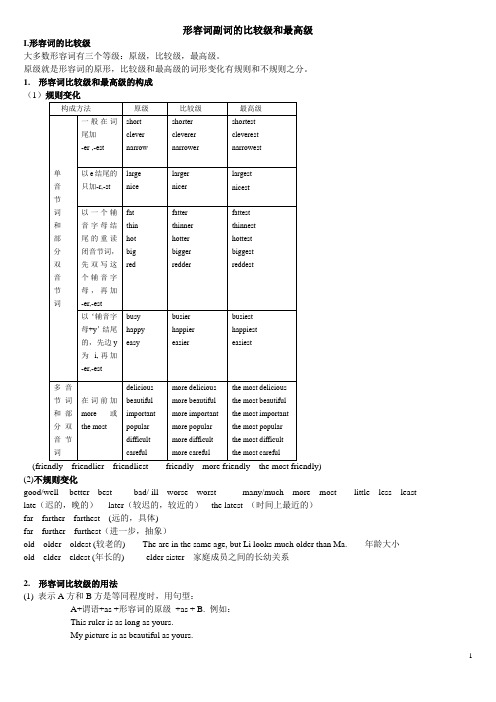
形容词副词的比较级和最高级I.形容词的比较级大多数形容词有三个等级:原级,比较级,最高级。
原级就是形容词的原形,比较级和最高级的词形变化有规则和不规则之分。
1.形容词比较级和最高级的构成(1)规则变化(friendly---friendlier---friendliest friendly---more friendly---the most friendly)(2)不规则变化good/well ---better---best bad/ ill---worse---worst many/much---more---most little---less---leastlate(迟的,晚的)--- later(较迟的,较近的)---the latest (时间上最近的)far---farther---farthest (远的,具体)far---further---furthest(进一步,抽象)old---older---oldest (较老的) The are in the same age, but Li looks much older than Ma. 年龄大小old---elder---eldest (年长的) elder sister 家庭成员之间的长幼关系2.形容词比较级的用法(1) 表示A方和B方是等同程度时,用句型:A+谓语+as +形容词的原级+as + B. 例如:This ruler is as long as yours.My picture is as beautiful as yours.1(2) 表示A方超过B方的时,用基本句型A+谓语(系动词)+形容词的比较级+than+B, 例如:This pen is better than that oneThe weather here is hotter than that in your hometownI have more books than you haveThis book is more interesting than that one.There are more books in your library than in theirs(3) 比较级+and +比较级表示“越来越……”It’s getting darker and darker .He is more and more interested in physics.(4) 比较级前面可以用一些表示程度的状语,例如:much , many, a lot, a little , even, a bit ,farShe made much greater progress this term than she did last term.He is a bit taller than I.3, 形容词的最高级:最高级用于三个或者三个以上的人或者事物的比较,其基本的句式是:主语+谓语(系动词或者行为动词)+the+最高级+表示比较的范围的介词短语和从句,例如:She is the most active student in her class.She is the cleverest girl of the three .This is the most interesting book that I have ever read.The Great Wall is the longest wall in the world.Which is the heaviest, the horse, the sheep or the elephant?Tom is the tallest boy of the three.(1 ) one of +最高级+名词的复数+ 谓语单数One of the most famous countries in the world is China.Y ou are one of the best students in our class.II.副词用来修饰动词,形容词,其他副词或全句,说明时间,地点,程度及方式等。
形容词和副词的比较级和最高级全面解析
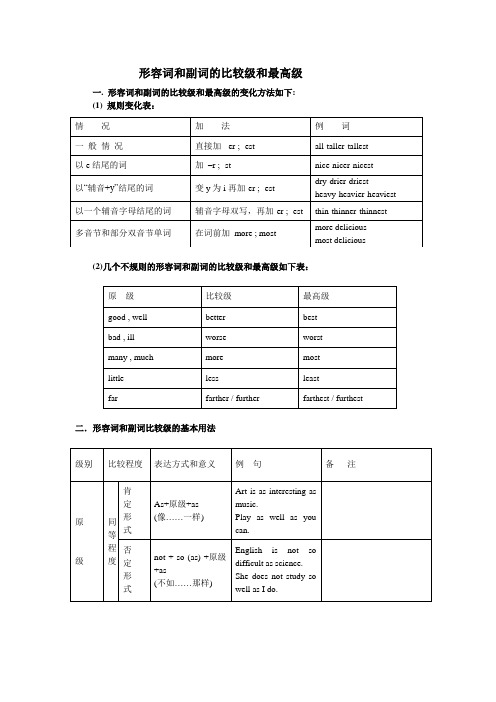
形容词和副词的比较级和最高级一. 形容词和副词的比较级和最高级的变化方法如下:(1) 规则变化表:(2)几个不规则的形容词和副词的比较级和最高级如下表:二.形容词和副词比较级的基本用法三.形容词副词比较级最高级的特殊用法(1)和冠词连用the +形容词原级+v(复),指一类人或物the +形容词比较级,指两者中―较…的‖的那一个,eg. the younger of the twoa/ an +形容词比较级eg. The pen is expensive. I want a cheaper one.a+most不是最高级相当于very,修饰其后的名词―非常…‖eg. a most beautiful city the+most表示最高级the most wonderful movie(2)序数词与最高级连用,如:Flying is the fastest and the second cheapest way to travel.(3)比较级+than any other +n. (单)(适用于范围一致时)(all) other +n.(复)any +n.(单) (适用于范围不一致时)any other student / all other students in his class.他是他们班最高any student in my class.他比我们班上任何一个同学都高。
(4)倍数表达法。
1. 倍数+ as + 形容词或副词的原级+ as + 其他。
这种结构又常演变成下列两类:①倍数+ as + many + 可数名词复数+ as;②倍数+ as +much + 不可数名词+ as。
如:There are seven times as many people as I expected.是我预料的人数的七倍。
There is five times as much coffee in this glass as in that one.这个杯子里的咖啡是那个杯子里的五倍。
形容词和副词比较级的变化规则

形容词和副词比较级的变化规则•相关推荐形容词和副词比较级的变化规则形容词、副词比较级大多数形容词(性质形容词)和副词有比较级和最高级的变化,即原级、比较级和最高级,用来表示事物的等级差别。
原级即形容词的原形,比较级和最高级有规则变化和不规则变化两种。
1)规则变化构成法一般单音节词末尾加-er,-est原级:tall(高的 great(巨大的)比较级:taller greater最高级:tallest greatest以不发音的e结尾的单音词和少数以- le结尾的双音节词只加-r,-st原级:nice(好的) large(大的`) able(有能力的)比较级:nicer larger abler最高级nicest largest ablest以一个辅音字母结尾的闭音节单音节词,双写结尾的辅音字母,再加-er,-est 原级:big(大的) hot(热的)比较级:bigger hotter最高级:biggest hottest以辅音字母+y结尾的双音节词,改y为i,再加-er,-est原级:easy(容易的) busy(忙的)比较级:easier busier最高级:easiest busiest少数以-er,-ow结尾的双音节词未尾加-er,-est原级:clever(聪明的) narrow(窄的)比较级:cleverer narrower最高级:cleverest narrowest其他双音节词和多音节词,在前面加more,most来构成比较级和最高级。
原级:important(重要的) easily(容易地)比较级:more important more easily最高级:most important most easily2)不规则变化原级:good(好的) bad(坏的)比较级:better worse最高级:best worst1副词:1) 时间和频度副词: now, then, often, always, usually, early, today, lately, next, last, already, generally, frequently, seldom, ever, never ,yet ,soon ,too, immediately, hardly, finally, shortly, before, ago, sometimes, yesterday. 2) 地点副词: here, there, everywhere, anywhere, in, out, inside, outside, above, below, down, back, forward, home, upstairs, downstairs, across, along, round , around, near, off, past, up, away, on. 3) 方式副词: carefully, properly, anxiously, suddenly, normally, fast, well, calmly, politely, proudly, softly, warmly 4) 程度副词: much ,little, very, rather, so, too, still, quite, perfectly, enough, extremely, entirely, almost, slightly. 5) 疑问副词: how, when, where, why. 6) 关系副词: when, where, why. 7) 连接副词: how, when, where, why, whether.As…as的一般用法:其基本意思为“与…一样”,其中的第一个as为副词,其后通常接形容词或副词(用原级),第二个as可用作介词(后接名词或代词)或连词(后接从句)。
形容词和副词的比较级和最高级
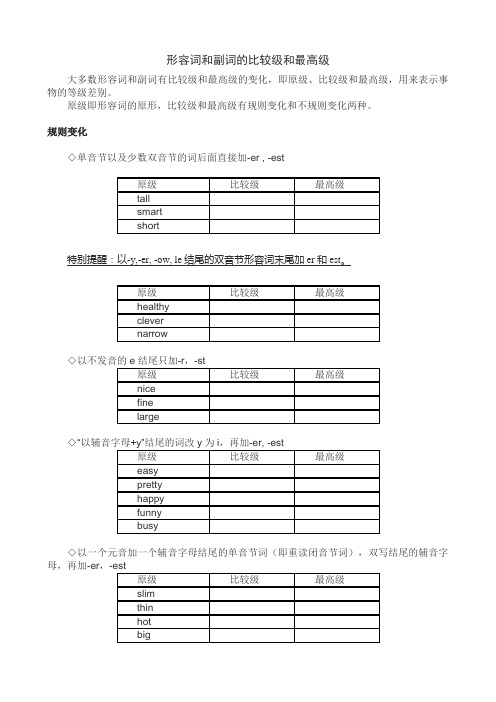
形容词和副词的比较级和最高级
大多数形容词和副词有比较级和最高级的变化,即原级、比较级和最高级,用来表示事物的等级差别。
原级即形容词的原形,比较级和最高级有规则变化和不规则变化两种。
规则变化
◇单音节以及少数双音节的词后面直接加-er , -est
特别提醒:以-y,-er, -ow, le结尾的双音节形容词末尾加er和est。
◇“
◇以一个元音加一个辅音字母结尾的单音节词(即重读闭音节词),双写结尾的辅音字母,再加-er,
◇大部分双音节词和多音节的词(即音标中含有三个或三个以上元音音素的词),要在前面加more
如unhappy----unhappier----unhappiest,
untidy----untidier----untidiest
◇由ing分词和耳朵ed分词演变过来的形容词(包括不规则动词如know→known)只能加more或
不规则变化
特别提醒:◇further不仅可以指“距离更远”,还可指“程度更深”。
记住以下三个词组:(进修)
(进一步的信息)
◇elder仅用于同辈之间的排行,如:
(姐姐)
(哥哥)。
- 1、下载文档前请自行甄别文档内容的完整性,平台不提供额外的编辑、内容补充、找答案等附加服务。
- 2、"仅部分预览"的文档,不可在线预览部分如存在完整性等问题,可反馈申请退款(可完整预览的文档不适用该条件!)。
- 3、如文档侵犯您的权益,请联系客服反馈,我们会尽快为您处理(人工客服工作时间:9:00-18:30)。
形容词副词比较级和最高级有规则变化和不规则变化
规则变化
(1)一般情况下,单音节或双音节的形容词(或副词)比较级+er ,最高级+est
如:
clever-cleverer-cleverest
few-fewer-fewest
small-smaller-smallest等
(2)以e结尾的词,比较级+r,最高级+st即可
如:
nice-nicer-nicest
cute-cuter-cutest
large-larger-largest
(3)以辅音字母+y结尾的变y为i+er或est
如:
easy-easier-easiest
happy-happier-happiest
再如:early , busy , heavy , dirty , lazy . 也如此
(4)双写最后一个辅音字母+er或est的词同学要用心去记。
1. fat-fatter-fattest
2. thin-thinner-thinnest
3. hot-hotter-hottest
4. red-redder-reddest
5. wet-wetter-wettest
6. big-bigger-biggest
(5)多音节和部分双音节的词需要在形容词原级前+more构成比较级,+the most构成最高级。
如:
beautiful -more beautiful -the most beautiful .
delicious , popular , important ,
interesting , expensive
双音节的词如
careful-more careful -the most careful
useful -more useful -the most useful .
少数单音节词也是这样如:
pleased-more pleased -the most pleased
tired-more tried -the most tired
不规则变化:
bad-worse worst
如有侵权请联系告知删除,感谢你们的配合!。
